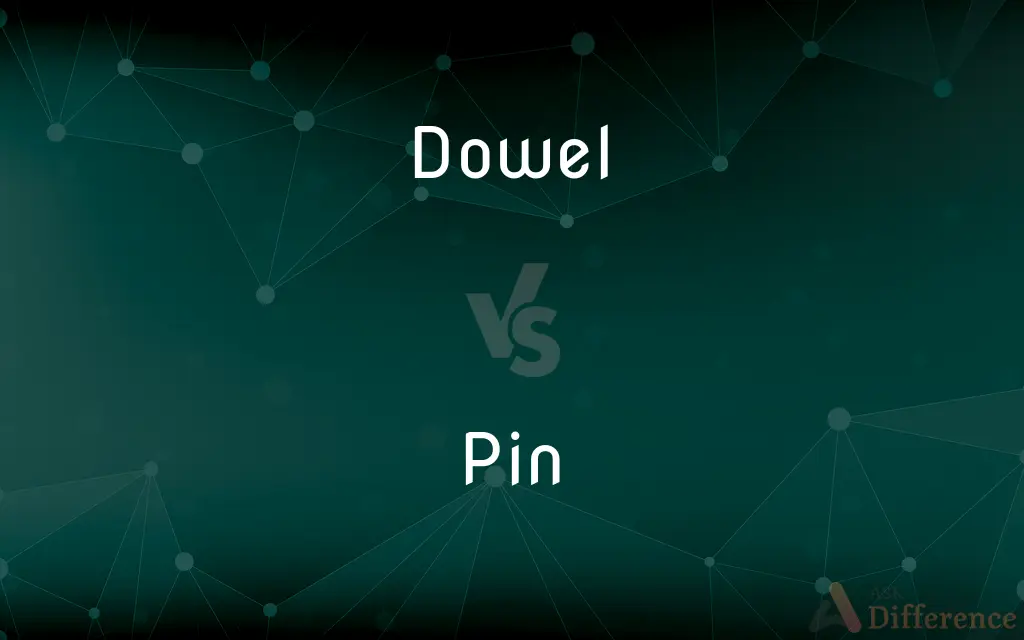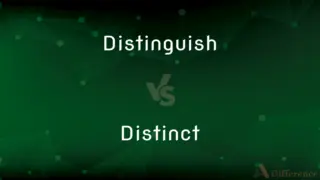Dowel vs. Pin — What's the Difference?
By Maham Liaqat & Urooj Arif — Updated on April 8, 2024
Dowels are cylindrical rods primarily used in woodworking for joining parts, whereas pins can vary in shape and are used for fastening or aligning components in various applications.

Difference Between Dowel and Pin
Table of Contents
ADVERTISEMENT
Key Differences
Dowels are often made from wood and serve as structural reinforcements in carpentry and woodworking projects. They fit into corresponding holes in two adjoining pieces to ensure a precise alignment and a strong joint. On the other hand, pins are typically metal and come in various shapes like straight, tapered, or rolled, designed to fasten or align parts in mechanical and construction applications.
While dowels are usually hidden within the workpiece, contributing to the aesthetics of the finished product by not being visible on the surface, pins might be exposed or partially exposed, depending on their function. For example, cotter pins are used where easy removal or adjustment is necessary.
The selection between a dowel and a pin often depends on the material of the components being joined. Dowels are preferred in woodworking due to their compatibility with wood and the strength they provide, whereas pins are chosen for metal, plastic, or mixed materials because of their durability and resistance to shear forces.
Dowels require precise drilling of holes for insertion, making the alignment crucial for the joint's integrity. Conversely, pins, especially those used in machinery, can be inserted into pre-existing holes and secured with additional components like washers or clips, offering flexibility in application.
In terms of availability and customization, dowels can be easily made to specific sizes from any wood stick or purchased in standard diameters, providing versatility for custom projects. Pins, however, are often manufactured in standard sizes and materials, making them readily available but potentially limiting in projects requiring unique specifications.
ADVERTISEMENT
Comparison Chart
Primary Material
Usually wood
Usually metal
Main Use
Joining wood pieces
Fastening or aligning components
Visibility
Hidden within workpiece
Can be exposed or partially
Material Compatibility
Best with wood
Suited for metal, plastic, or mixed materials
Installation
Requires precise hole drilling
Inserted into pre-existing holes
Customization
Easily made to specific sizes
Standard sizes, limited customization
Function
Structural reinforcement
Fastening, alignment, easy removal
Compare with Definitions
Dowel
Invisible in the final product, contributing to a clean aesthetic.
The dowels allowed for a seamless connection between the table legs and top.
Pin
Comes in various shapes and sizes for different applications.
For the hinge, a tapered pin was used to allow for easy assembly and disassembly.
Dowel
Made primarily from wood for compatibility with woodworking projects.
For the wooden bed frame, he chose hardwood dowels for their durability.
Pin
A small, typically metal fastener used for securing or aligning parts.
She used a pin to secure the components of the metal sculpture.
Dowel
A cylindrical rod inserted into corresponding holes in two adjoining pieces to create a joint.
The carpenter used a dowel to join the two pieces of the chair frame.
Pin
Often used in mechanical applications for its strength and durability.
Pins in the engine must withstand high temperatures and forces.
Dowel
A tool for ensuring alignment and strength in woodworking.
Dowels are essential for maintaining the integrity of bookshelf corners.
Pin
Suited for a wide range of materials, including metal and plastic.
Plastic pins were used to align the parts of the toy model accurately.
Dowel
Requires precision in drilling and fitting for effectiveness.
He carefully measured and drilled the holes to ensure the dowels would fit perfectly.
Pin
Can be easily inserted and removed if necessary, offering flexibility.
The cotter pin can be removed to adjust the wheel alignment.
Dowel
A dowel is a cylindrical rod, usually made from wood, plastic, or metal. In its original manufactured form, a dowel is called a dowel rod.
Pin
A pin is a device used for fastening objects or material together, and can have three sorts of body: a shaft of a rigid inflexible material meant to be inserted in a slot, groove, or hole (as with pivots, hinges, and jigs); a shaft connected to a head and ending in a sharp tip meant to pierce one or more pieces of soft materials like cloth or paper (the straight or push pin); a single strip of a rigid but flexible material (e.g. a wire) whose length has been folded into parallel prongs in such fashion that the middle length of each curves towards the other so that, when anything is inserted between them, they act as a clamp (e.g.
Dowel
A usually round pin that fits tightly into a corresponding hole to fasten or align two adjacent pieces.
Pin
An identifying number allocated to an individual by a bank or other organization and used for validating electronic transactions.
Dowel
A piece of wood driven into a wall to act as an anchor for nails.
Pin
Attach or fasten with a pin or pins
Her hair was pinned back
He pinned the badge on to his lapel
Dowel
To fasten or align with dowels
Table legs that are doweled to the top.
Pin
Hold (someone) firmly in a specified position so they are unable to move
Richards pinned him down until the police arrived
She was standing pinned against the door
Dowel
To equip with dowels.
Pin
Hinder or prevent (a piece or pawn) from moving because of the danger to a more valuable piece standing behind it along the line of an attack
The black rook on e4 is pinned
Dowel
A pin, or block, of wood or metal, fitting into holes in the abutting portions of two pieces, and being partly in one piece and partly in the other, to keep them in their proper relative position.
Pin
A short, straight, stiff piece of wire with a blunt head and a sharp point, used especially for fastening.
Dowel
A wooden rod, as one to make short pins from.
Pin
Something, such as a safety pin, that resembles such a piece of wire in shape or use.
Dowel
(construction) A piece of wood or similar material fitted into a surface not suitable for fastening so that other pieces may be fastened to it.
Pin
A whit; a jot
Didn't care a pin about the matter.
Dowel
(transitive) To fasten together with dowels.
Pin
A thin rod for securing the ends of fractured bones.
Dowel
(transitive) To furnish with dowels.
A cooper dowels pieces for the head of a cask.
Pin
A peg for fixing the crown to the root of a tooth.
Dowel
A pin, or block, of wood or metal, fitting into holes in the abutting portions of two pieces, and being partly in one piece and partly in the other, to keep them in their proper relative position.
Pin
A cotter pin.
Dowel
A piece of wood driven into a wall, so that other pieces may be nailed to it.
Pin
The part of a key stem entering a lock.
Dowel
To fasten together by dowels; to furnish with dowels; as, a cooper dowels pieces for the head of a cask.
Pin
(Music) One of the pegs securing the strings and regulating their tension on a stringed instrument.
Dowel
A fastener that is inserted into holes in two adjacent pieces and holds them together
Pin
(Nautical) A belaying pin.
Pin
(Nautical) A thole pin.
Pin
An ornament fastened to clothing by means of a clasp.
Pin
A rolling pin.
Pin
One of the wooden clubs at which the ball is aimed in bowling.
Pin
A flagstick.
Pin
See fall.
Pin
Pins(Informal) The legs
Is steady on his pins.
Pin
(Electronics) A lead on a device that plugs into a socket to connect the device to a system.
Pin
Any of the pegs on the platen of a printer, which engage holes at the edges of paper.
Pin
Any of the styluses that form a dot matrix on a printer.
Pin
Any of the small metal prongs at the end of a connector that fit into the holes in a port.
Pin
To fasten or secure with or as if with a pin or pins.
Pin
To transfix.
Pin
To place in a position of trusting dependence
He pinned his faith on an absurdity.
Pin
To hold fast; immobilize
He was pinned under the wreckage of the truck.
Pin
(Sports) To win a fall from in wrestling.
Pin
To give (a woman) a fraternity pin in token of attachment.
Pin
Having a grain suggestive of the heads of pins. Used of leather.
Pin
A needle without an eye (usually) made of drawn-out steel wire with one end sharpened and the other flattened or rounded into a head, used for fastening.
Pin
A small nail with a head and a sharp point.
Pin
A cylinder often of wood or metal used to fasten or as a bearing between two parts.
Pull the pin out of the grenade before throwing it at the enemy.
Pin
The victory condition of holding the opponent's shoulders on the wrestling mat for a prescribed period of time.
Pin
A slender object specially designed for use in a specific game or sport, such as skittles or bowling.
Pin
A leg.
I'm not so good on my pins these days.
Pin
(electricity) Any of the individual connecting elements of a multipole electrical connector.
The UK standard connector for domestic mains electricity has three pins.
Pin
A piece of jewellery that is attached to clothing with a pin.
Pin
(US) A simple accessory that can be attached to clothing with a pin or fastener, often round and bearing a design, logo or message, and used for decoration, identification or to show political affiliation, etc.
Pin
(chess) Either a scenario in which moving a lesser piece to escape from attack would expose a more valuable piece to being taken instead, or one where moving a piece is impossible as it would place the king in check.
Pin
(golf) The flagstick: the flag-bearing pole which marks the location of a hole
Pin
(curling) The spot at the exact centre of the house (the target area)
The shot landed right on the pin.
Pin
(archery) The spot at the exact centre of the target, originally a literal pin that fastened the target in place.
Pin
(obsolete) A mood, a state of being.
Pin
One of a row of pegs in the side of an ancient drinking cup to mark how much each person should drink.
Pin
Caligo.
Pin
A thing of small value; a trifle.
Pin
A peg in musical instruments for increasing or relaxing the tension of the strings.
Pin
(engineering) A short shaft, sometimes forming a bolt, a part of which serves as a journal.
Pin
The tenon of a dovetail joint.
Pin
A size of brewery cask, equal to half a firkin, or eighth of a barrel.
Pin
(informal) A pinball machine.
I spent most of my time in the arcade playing pins.
Pin
(locksmithing) A small cylindrical object which blocks the rotation of a pin-tumbler lock when the incorrect key is inserted.
Pin
(often followed by a preposition such as "to" or "on") To fasten or attach (something) with a pin.
Pin
To cause (a piece) to be in a pin.
Pin
(wrestling) To pin down (someone).
He pinned his opponent on the mat.
Pin
To enclose; to confine; to pen; to pound.
Pin
To attach (an icon, application, message etc.) to another item so that it persists.
To pin a folder to the taskbar
Pin
To fix (an array in memory, a security certificate, etc.) so that it cannot be modified.
When marshaling data, the interop marshaler can copy or pin the data being marshaled.
Pin
5.0|page=244
Pin
(transitive) To cause an analog gauge to reach the stop pin at the high end of the range.
Pin
To peen.
Pin
To inclose; to confine; to pen; to pound.
Pin
To fasten with, or as with, a pin; to join; as, to pin a garment; to pin boards together.
Pin
A piece of wood, metal, etc., generally cylindrical, used for fastening separate articles together, or as a support by which one article may be suspended from another; a peg; a bolt.
With pins of adamantAnd chains they made all fast.
Pin
Especially, a small, pointed and headed piece of brass or other wire (commonly tinned), largely used for fastening clothes, attaching papers, etc.
Pin
Hence, a thing of small value; a trifle.
He . . . did not care a pin for her.
Pin
That which resembles a pin in its form or use
Pin
One of a row of pegs in the side of an ancient drinking cup to mark how much each man should drink.
Pin
The bull's eye, or center, of a target; hence, the center.
Pin
Mood; humor.
Pin
Caligo. See Caligo.
Pin
An ornament, as a brooch or badge, fastened to the clothing by a pin; as, a Masonic pin.
Pin
The leg; as, to knock one off his pins.
Pin
A piece of jewelry that is pinned onto the wearer's garment
Pin
When a wrestler's shoulders are forced to the mat
Pin
Small markers inserted into a surface to mark scores or define locations etc.
Pin
A number you choose and use to gain access to various accounts
Pin
Informal terms of the leg;
Fever left him weak on his sticks
Pin
Axis consisting of a short shaft that supports something that turns
Pin
Cylindrical tumblers consisting of two parts that are held in place by springs; when they are aligned with a key the bolt can be thrown
Pin
Flagpole used to mark the position of the hole on a golf green
Pin
A small slender (often pointed) piece of wood or metal used to support or fasten or attach things
Pin
A club-shaped wooden object used in bowling; set up in groups as a target
Pin
To hold fast or prevent from moving;
The child was pinned under the fallen tree
Pin
Attach or fasten with pins
Pin
Pierce with a pin;
Pin down the butterfly
Pin
Immobilize a piece
Common Curiosities
Are pins always made of metal?
Pins are commonly made of metal for strength and durability, but they can also be made from plastic, wood, or other materials depending on the application.
How do you choose between using a dowel or a pin?
The choice between a dowel and a pin depends on the materials being joined, the desired strength of the joint, and whether the fastener should be visible or not.
Can dowels be made from materials other than wood?
Yes, while dowels are traditionally made from wood, they can also be found in metal, plastic, and other materials for specific applications.
What is a dowel used for?
A dowel is primarily used in woodworking to join two pieces of wood together, providing alignment and strength to the joint.
Is precision important when using dowels?
Yes, precision in drilling holes for dowels is crucial for ensuring the joint's strength and alignment.
Are there different types of pins?
Yes, there are various types of pins, including straight, tapered, cotter, and roll pins, each designed for specific uses.
How are dowels sized?
Dowels are sized based on their diameter and length, which can be chosen to suit the specific requirements of the joint.
How does a pin differ from a dowel in application?
A pin can be used for fastening or aligning components in various applications, including mechanical and construction projects, offering versatility beyond woodworking.
How do you secure a pin in place?
Pins can be secured with friction, clips, or other mechanical fasteners, depending on the type of pin and its application.
Can pins be used in woodworking?
Yes, pins can be used in woodworking, especially for temporary alignment or where metal components are incorporated.
What materials are suitable for pins?
Materials for pins include metal for strength and durability, plastic for electrical insulation, and wood for specific aesthetic or material compatibility reasons.
What are the advantages of using dowels in woodworking?
Dowels offer a strong, invisible joint that enhances the aesthetic of the finished product and is well-suited to the material properties of wood.
Do dowels add strength to a joint?
Yes, dowels add significant strength to a joint by distributing load and stress over a larger area.
What is the role of a pin in mechanical assemblies?
In mechanical assemblies, pins often serve to align components, allow for movement, or secure parts together against separation.
Can pins be custom made?
While pins are generally available in standard sizes, custom pins can be manufactured for specific applications.
Share Your Discovery

Previous Comparison
Distinguish vs. Distinct
Next Comparison
Pact vs. CompactAuthor Spotlight
Written by
Maham LiaqatCo-written by
Urooj ArifUrooj is a skilled content writer at Ask Difference, known for her exceptional ability to simplify complex topics into engaging and informative content. With a passion for research and a flair for clear, concise writing, she consistently delivers articles that resonate with our diverse audience.














































